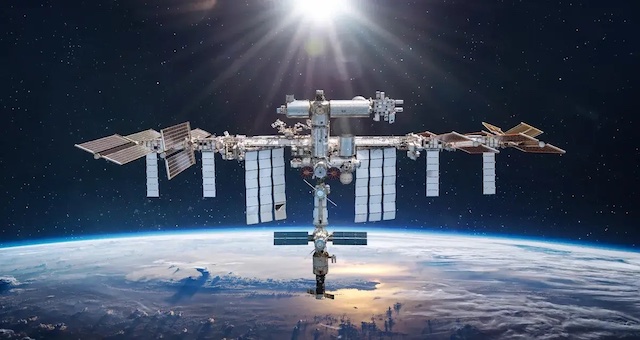
INTERNATIONAL SPACE STATION
INTERNATIONAL SPACE STATION POLLUTED WITH HARMFUL CHEMICALS
BY: MRIGAKSHI DIXITORIGINAL SITE: INTERESTING ENGINEERING
TOPICS
Activism
AI
Belief
Big Pharma
Conspiracy
Cult
Culture
Deep State
Education
Entertainment
Environment
Faith
Global
Government
Health
Hi Tech
Leadership
Politics
Prophecy
Science
Security
Social Climate
Universe
War
The study found that the concentration of chemical contaminants on the ISS notably exceeds that of dust on the floors of homes in the United States and Western Europe.
The International Space Station (ISS) is found to be contaminated by high amounts of potentially harmful chemical pollutants.
This conclusion was reached through a first-of-its-kind analysis of dust samples retrieved from the ISS's air filtering system.
Surprisingly, the investigation revealed that the concentration of chemical contaminants on the orbiting space station notably exceeds that of dust found on the floors of homes in the United States and Western Europe.
This may sound scary for health, but astronauts should not be concerned just yet.
“While concentrations of organic contaminants discovered in dust from the ISS often exceeded median values found in homes and other indoor environments across the US and western Europe, levels of these compounds were generally within the range found on Earth,” said Stuart Harrad, study co-author from the University of Birmingham, in an official release.
Chemicals found in the air filters
The scientists examined vacuum bags from the ISS HEPA filters returned to Earth for this investigation. Moreover, the "space dust" samples were compared with the organic pollutants in American homes.
A diverse variety of chemical pollutants were detected in the space dust samples, which mainly included polybrominated diphenyl ethers (PBDEs), hexabromocyclododecane (HBCDD), novel brominated flame retardants (BFRs), organophosphate esters (OPEs), polycyclic aromatic hydrocarbons (PAH), perfluoroalkyl substances (PFAS), and polychlorinated biphenyls (PCBs).
The applications for BFRs and OPEs include electrical and electronic equipment, building insulation, furniture textiles, and foams. These compounds are also used to ensure fire safety regulations.
PAHs are often found in hydrocarbon fuels and are released during combustion processes.
PCBs are commonly used in building and window sealants, as well as electrical equipment. While PFAS, also known as forever chemicals, are found in fabrics and clothing.
However, the authors highlight that the chemicals' impacts on human health have resulted in some being banned or restricted for usage.
According to the UNEP Stockholm Convention, some substances are designated persistent organic pollutants (POPs), while some PAH are listed as human carcinogens.
But how did these chemicals end up on board the space station?
Chemicals are ubiquitous in our daily lives and widely used in various applications.
As per the official release, the “off-the-shelf items” brought on board by astronauts for personal use, like cameras, MP3 players, tablet computers, medical gadgets, and clothes, could be probable sources of several of the chemicals found in the study.
While some chemical contaminants could originate from the existing space station's infrastructure.
Meanwhile, onboard the ISS, some systems continually recirculate inside the air at a pace of eight to ten changes each hour.
This methodology allows for eliminating carbon dioxide and gaseous trace pollutants, but the extent to which chemicals like BFRs are removed is unknown.
The researchers hope their results will help engineers design and build better long-term human space stations.
“Our findings have implications for future space stations and habitats, where it may be possible to exclude many contaminant sources by careful material choices in the early stages of design and construction,” said Harrad.
The findings were published in the journal Environmental Science and Technology Letters .
